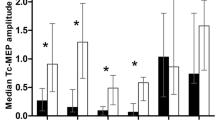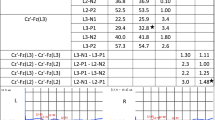Abstract
Purpose
Combined intraoperative monitoring (IOM) of transcranial electric motor-evoked potentials (tce-MEPs) and somatosensory-evoked potentials (SSEPs) is safe and effective for spinal cord monitoring during scoliosis surgery. However, the literature data regarding the reliability of spinal cord monitoring in patients with neuromuscular scoliosis are conflicting and need to be confirmed.
Methods
We reviewed IOM records of 40 consecutive patients with neuromuscular scoliosis related to central nervous system (CNS) (29 pts) or peripheral nervous system (PNS) (11 patients) diseases, who underwent posterior fusion with instrumentation surgery for spinal deformity. Multimodalitary IOM with SSEPs and tce-MEPs was performed.
Results
Spinal cord monitoring using at least one modality was attempted in 38/40 (95 %) patients. No false-negative results were present in either group, but a relatively high incidence of false-positive cases (4/29, 13.8 %) was noted in the CNS group. Two patients in the CNS group and one patient in the PNS group presented transient postoperative motor deficits (true positive), related to surgical manoeuvres in two cases and to malposition in the other one.
Conclusions
Multimodalitary IOM is safe and effective to detect impending spinal cord and peripheral nerves dysfunction in neuromuscular scoliosis surgery. However, the interpretation of neurophysiological data may be challenging in such patients, and the rate of false-positive results is high when pre-operatory motor deficits are severe.
Similar content being viewed by others
References
Greggi T, Martikos K, Lolli F, Bakaloudis G, Di Silvestre M, Cioni A, BarbantiBròdano G, Giacomini S (2010) Treatment of scoliosis in patients affected with Prader-Willi syndrome using various techniques. Scoliosis. doi:10.1186/1748-7161-5-11
Weiss HR, Goodall D (2008) Rate of complications in scoliosis surgery—a systematic review of the Pub Med literature. Scoliosis. doi:10.1186/1748-7161-3-9
Pajewski TN, Arlet V, Lawrence H (2007) Current approach on spinal cord monitoring: the point of view of the neurologist, the anesthesiologist and the spine surgeonPhillipsEur. Spine J 16(Suppl 2):115–129
Nuwer MR, Emerson RG, Galloway G, Legatt AD, Lopez J, Minahan R, Yamada T, Goodin DS, Armon C, Chaudry V, Gronseth GS, Harden CL, Therapeutics and Technology Assessment Subcommittee of the American Academy of Neurology; American Clinical Neurophysiology Society (2012) Evidence-based guideline update: intraoperative spinal monitoring with somatosensory and transcranial motor evoked potentials: report of the Therapeutics and Technology Assessment Subcommittee of the American Academy of Neurology and the American Clinical Neurophysiology Society. Neurology 78(8):585–589
Raynor BL, Bright JD, Lenke LG, Rahman RKK, Bridwell KH, Riew KD, Buchowski JM, Luhmann SJ, Padberg AM (2013) Significant change or loss of intraoperative monitoring data. A 25-year experience in 12,375 spinal surgeries. Spine 38:E101–E108
Hammett TC, Boreham B, Quraishi NA, Mehdian SMH (2013) Intraoperative spinal cord monitoring during the surgical correction of scoliosis due to cerebral palsy and other neuromuscular disorders. Eur Spine J 22(Suppl 1):38–41
Tucker SK, Noorden MHH, Pitt MC (2001) Spinal cord monitoring in neuromuscolar scoliosis. J Pediatr Orthop Part B 10(1):1–5
Lipton GE, Miller F, Dabney KW et al (1999) Factors predicting postoperative complications following spinal fusions in children with cerebral palsy. J Spinal Disord 12:197–205
Master DL, Son-Hing JP, Poe-Kochert C, Armstrong DG, Thompson GH (2011) Risk factors for major comlications after surgery for neuromuscular scoliosis. Spine 36:564–571
Pastorelli F, Di Silvestre M, Plasmati R, Michelucci R, Greggi T, Morigi A, Bacchin MR, Cioni A, Vommaro F, Fini N, Lolli F, Parisini P (2011) The prevention of neural complications in the surgical treatment of scoliosis: the role of the neurophysiological intraoperative monitoring. Eur Spine J 20(Suppl 1):S105–S114
Wilson-Holden TJ, Padberg AM, Lenke LG, Larson BJ, Bridwell KH, Bassett GS (1999) Efficacy of intraoperative monitoring for pediatric patients with spinal cord pathology undergoing spinal deformity surgery. Spine 24:1685–1692
DiCindio S, Theroux M, Shah S, Freeman Miller, Dabney K, Brislin R, Schwartz D (2003) Multimodality monitoring of transcranial electric motor and somatosensory-evoked potentials during surgical correction of spinal deformity in patients with cerebral palsy and other neuromuscular disorders. Spine 28:1851–1856
Thuet ED, Padberg AM, Raynor BL, Bridwell KH, Riew KD, Taylor BA, Lenke LG (2005) Increased risk of postoperative deficit for spinal surgery patients with unobtainable intraoperative evoked potential data. Spine 30:2094–2103
Sala F, Manganotti P, Grossauer S, Tramontanto V, Mazza C, Gerosa M (2010) Intraoperative neurophysiology of the motor sustem in children: a tailored approach. Childs Nerv Syst 26:473–490
Patel AJ, Agadi S, Thomas JG, Schmidt RJ, Hwang SW, Fulkerson DH, Glover CD, Jea A (2013) Neurophysiologic intraoperative monitoring in children with Down syndrome. Childs Nerv Syst 29:281–287
Schwartz DM, Auerbach JD, Dormans JP et al (2007) Neurophysiological detection of impending spinal cord injury during scoliosis surgery. J Bone Joint Surg Am 89:2440–2449
Chen Z, Lerman J (2012) Protection of the remaining spinal cord function with intraoperative neurophysiological monitoring during paraparetic scoliosis surgery: a case report. J Clin Monit Comput 26:13–16
Jarvis JG, Strantzas S, Lipkus M et al (2013) Responding to neuromonitoring changes in 3-column posterior spinal osteotomies for rigid pediatric spinal deformities. Spine 38(8):pE493–pE503
Kim CH, Hong JT, Chung CK et al (2014) Intraoperative electrophysiological monitoring during posterior craniocervical distraction and realignment for congenital craniocervical anomaly. Eur Spine J (Germany) 24(4):p671–p678
Mac Donald DB (2002) Safety of intraoperative transcranial electrical stimulation motor evoked potential monitoring. J Clin Neurophysiol 19:416–442
Author information
Authors and Affiliations
Corresponding author
Ethics declarations
Conflict of interest
None.
Rights and permissions
About this article
Cite this article
Pastorelli, F., Di Silvestre, M., Vommaro, F. et al. Intraoperative monitoring of somatosensory (SSEPs) and transcranial electric motor-evoked potentials (tce-MEPs) during surgical correction of neuromuscular scoliosis in patients with central or peripheral nervous system diseases. Eur Spine J 24 (Suppl 7), 931–936 (2015). https://doi.org/10.1007/s00586-015-4282-6
Received:
Revised:
Accepted:
Published:
Issue Date:
DOI: https://doi.org/10.1007/s00586-015-4282-6




